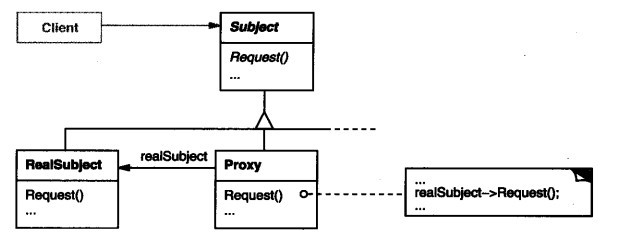首页 > 代码库 > 【设计模式】代理模式
【设计模式】代理模式
代理模式(Proxy)
关于代理,ITer做常见的应该就是用来翻鸡爱抚大不留的代理了。
生活中也有很多代理,比如在北京不收中介费的在租房中介,这帮人就叫代理,链家这样的房产中介也叫代理,只不过是收中介费的代理。
恰好今天中午在公司楼道里吃午饭(热干面,楼下超市买的),刚吃了几口,进来一个抽烟的哥们,进来跟我打招呼,应该是隔壁公司的,隔壁公司是家律所,他说他不是律师,是做专利的,也就是代理专利,一般介于客户和知识产权局和专利局之间,所以,他就是一个代理。
用下图来说明

代理模式的示意图如下

Subject是一些需要做的工作,只有一些接口,以专利来说,可以有:【提交申请】【提交材料】【交费】等;
RealSubject是真正去做事的人,RealSubject实现了Subject的接口
Proxy是代理,Proxy也实现了Subject的接口,其在这些接口的内部去调用RealSubject实现的相应接口。
代理模式隐藏了真正干活的人RealSubject, 由于提供给客户的是Proxy,所以RealSubject和Proxy应该是相关的。
下面以客户请专利公司代为申请专利为例子来描述,如下
申请专利需要的【申请专利】抽象类,接口
/************************************************************************
设计模式4
代理模式
代理模式,即客户和代理打交道,而代理又在内部调动相应的真正干活的人去干活
对客户来说,真正干活的人是透明的,他只和代理打交道。
以客户通过专利代理公司申请专利为例子来描述代理模式
************************************************************************/
//【申请专利】接口,声明了一组申请专利的操作
class IApplyZL
{
public:
IApplyZL();
virtual ~IApplyZL();
virtual void CommitApply() = 0; //提交申请
virtual void CommitFiles() = 0; //提交资料
virtual void Pay() = 0; //支付费用
};
IApplyZL::IApplyZL(){}
IApplyZL::~IApplyZL(){}
void IApplyZL::CommitApply() {}
void IApplyZL::CommitFiles() {}
void IApplyZL::Pay() {}
真正干活的【代理人/员工】类,员工类继承自IApplyZL抽象基类,实现了所有虚函数,表示员工可以干这个活
//【代理人】类,真正干活的人,他实现(有这样的能力)了申请专利要做的一些工作
class Worker : public IApplyZL
{
public:
Worker(string strClient);
virtual ~Worker();
virtual void CommitApply();
virtual void CommitFiles();
virtual void Pay();
protected:
string m_strClient; //客户名
};
Worker::Worker(string strClient) : m_strClient(strClient){}
Worker::~Worker(){}
void Worker::CommitApply()
{
cout << "\r\n我正在为 "<<m_strClient<<" 先生/女士 提交专利申请!\r\n";
}
void Worker::CommitFiles()
{
cout << "\r\n我正在为 "<<m_strClient<<" 先生/女士 提交专利申请需要的材料!\r\n";
}
void Worker::Pay()
{
cout << "\r\n我正在为 "<<m_strClient<<" 先生/女士 提交专利申请需要需要的费用!\r\n";
}
面向客户的【代理公司】类,他也继承自IApplyZL抽象基类,实现了所有虚函数,表示可以承接这样的业务
//【代理公司】类,客户跟代理公司打交道,代理公司实现了IApplyZL的接口,
//表示代理公司可以承接这样的业务
class ProxyZL : public IApplyZL
{
public:
ProxyZL(string strClient);
virtual ~ProxyZL();
virtual void CommitApply();
virtual void CommitFiles();
virtual void Pay();
protected:
Worker* m_pWorker; //干活的员工
string m_strClient; //客户名
};
ProxyZL::ProxyZL(string strClient) : m_strClient(strClient), m_pWorker(NULL) {}
ProxyZL::~ProxyZL(){}
void ProxyZL::CommitApply()
{
if(NULL == m_pWorker) m_pWorker = new Worker(m_strClient);
m_pWorker->CommitApply();
}
void ProxyZL::CommitFiles()
{
if(NULL == m_pWorker) m_pWorker = new Worker(m_strClient);
m_pWorker->CommitFiles();
}
void ProxyZL::Pay()
{
if(NULL == m_pWorker) m_pWorker = new Worker(m_strClient);
m_pWorker->Pay();
}
main函数以及执行情况
int _tmain(int argc, _TCHAR* argv[])
{
ProxyZL proxy("cuish");
proxy.CommitApply();
proxy.CommitFiles();
proxy.Pay();
cout<<endl<<endl;
return 0;
}

PS:
想到一个问题,总是感觉代理模式和简单工厂模式,策略模式很相似,可是相似在什么地方又不好说。假如在【ProxyZL】类中的成员Worker *m_pWorker改为某个继承自IApplyZL抽象基类的子类的子类,如下:
即class Workers : public IApplyZL{};
ProxyZL类的成员改为Workers *m_pSomeWorker; //某个员工
又有Workers类的若干个子类,Workers类可以继续为抽象基类,在ProxyZL类中根据构造函数的参数不同可以用Workers类的不同子类的实例(new 子类())的指针给m_pSomeWorker指针赋值,再根据多态的性质,即可去调用不同的子类去执行申请专利的操作。 如果是这样,那就和简单工厂/策略模式很类似了。
如下:
//【员工】类,仍然为抽象基类,没有实现IApplyZL中的纯虚函数
class Workers : public IApplyZL
{
public:
Workers(string strClient);
virtual ~Workers();
protected:
string m_strClient; //客户名
};
Workers::Workers(string strClient) : m_strClient(strClient){}
Workers::~Workers(){}
两个员工类
//【代理人1】类,真正干活的人,他实现(有这样的能力)了申请专利要做的一些工作
class Worker1 : public Workers
{
public:
Worker1(string strClient);
virtual ~Worker1();
virtual void CommitApply();
virtual void CommitFiles();
virtual void Pay();
protected:
const string m_strWorkerName;
};
Worker1::Worker1(string strClient) : Workers(strClient), m_strWorkerName(string("worker1")){}
Worker1::~Worker1(){}
void Worker1::CommitApply()
{
cout << "\r\n"<<m_strWorkerName<<"正在为 "<<m_strClient<<" 先生/女士 提交专利申请!\r\n";
}
void Worker1::CommitFiles()
{
cout << "\r\n"<<m_strWorkerName<<"正在为 "<<m_strClient<<" 先生/女士 提交专利申请需要的材料!\r\n";
}
void Worker1::Pay()
{
cout << "\r\n"<<m_strWorkerName<<"正在为 "<<m_strClient<<" 先生/女士 提交专利申请需要需要的费用!\r\n";
}
//////////////////////////////////////////////////////////////////////////
//【代理人2】类,真正干活的人,他实现(有这样的能力)了申请专利要做的一些工作
class Worker2 : public Workers
{
public:
Worker2(string strClient);
virtual ~Worker2();
virtual void CommitApply();
virtual void CommitFiles();
virtual void Pay();
protected:
const string m_strWorkerName; //客户名
};
Worker2::Worker2(string strClient) : Workers(strClient), m_strWorkerName(string("worker2")){}
Worker2::~Worker2(){}
void Worker2::CommitApply()
{
cout << "\r\n"<<m_strWorkerName<<"正在为 "<<m_strClient<<" 先生/女士 提交专利申请!\r\n";
}
void Worker2::CommitFiles()
{
cout << "\r\n"<<m_strWorkerName<<"我正在为 "<<m_strClient<<" 先生/女士 提交专利申请需要的材料!\r\n";
}
void Worker2::Pay()
{
cout << "\r\n"<<m_strWorkerName<<"我正在为 "<<m_strClient<<" 先生/女士 提交专利申请需要需要的费用!\r\n";
}
代理公司类
//【代理公司】类,客户跟代理公司打交道,代理公司实现了IApplyZL的接口,
//表示代理公司可以承接这样的业务
class ProxyZL : public IApplyZL
{
public:
ProxyZL(string strClient);
virtual ~ProxyZL();
virtual void CommitApply();
virtual void CommitFiles();
virtual void Pay();
protected:
Workers* m_pSomeWorker; //某个干活的员工
string m_strClient; //客户名
};
ProxyZL::ProxyZL(string strClient) : m_strClient(strClient)
{
if (m_strClient == string("cuish"))
{
m_pSomeWorker = new Worker1(m_strClient);
}
else if(m_strClient == string("zhangsan"))
{
m_pSomeWorker = new Worker2(m_strClient);
}
else
{
m_pSomeWorker = NULL;
}
}
ProxyZL::~ProxyZL()
{
if (NULL != m_pSomeWorker) delete m_pSomeWorker;
}
void ProxyZL::CommitApply()
{
if(NULL != m_pSomeWorker)
m_pSomeWorker->CommitApply();
}
void ProxyZL::CommitFiles()
{
if(NULL != m_pSomeWorker)
m_pSomeWorker->CommitFiles();
}
void ProxyZL::Pay()
{
if(NULL != m_pSomeWorker)
m_pSomeWorker->Pay();
}
客户端和执行结果
int _tmain(int argc, _TCHAR* argv[])
{
ProxyZL proxy("cuish");
proxy.CommitApply();
proxy.CommitFiles();
proxy.Pay();
cout<<endl<<endl;
ProxyZL proxy2("zhangsan");
proxy2.CommitApply();
proxy2.CommitFiles();
proxy2.Pay();
cout<<endl<<endl;
return 0;
}

嗯,有点像简单工厂模式和代理模式的结合了。
